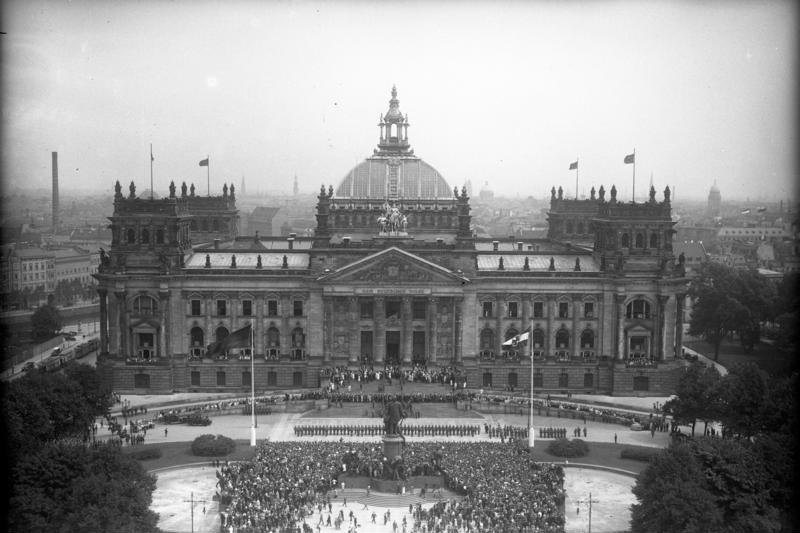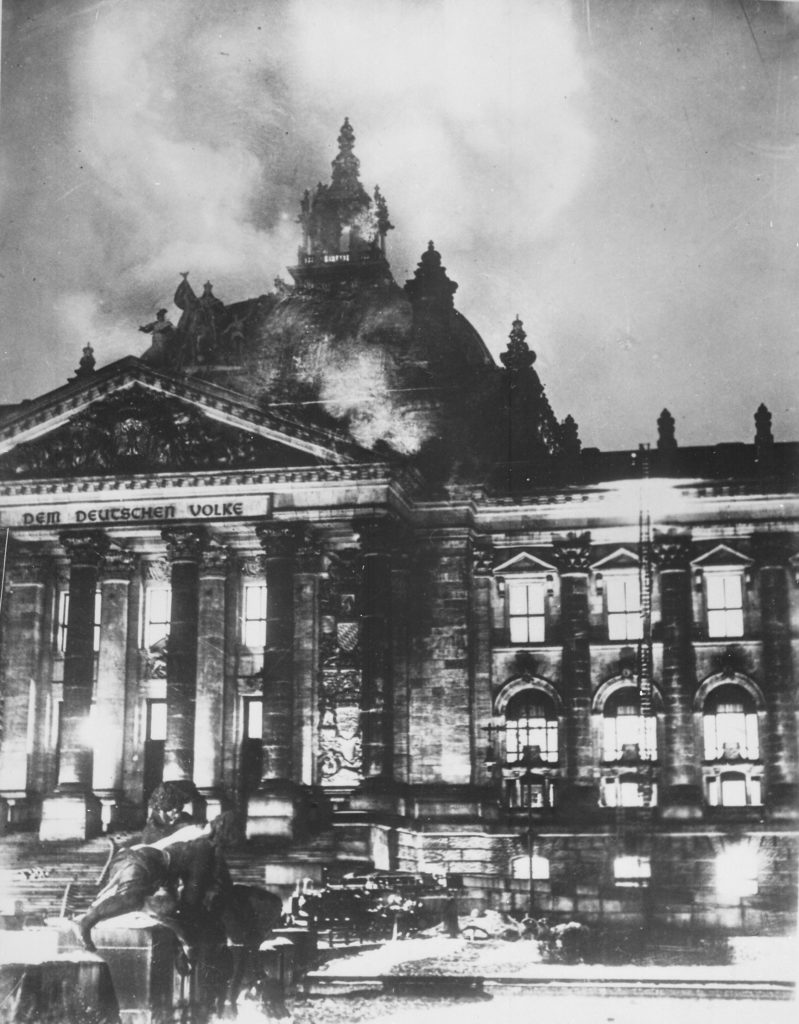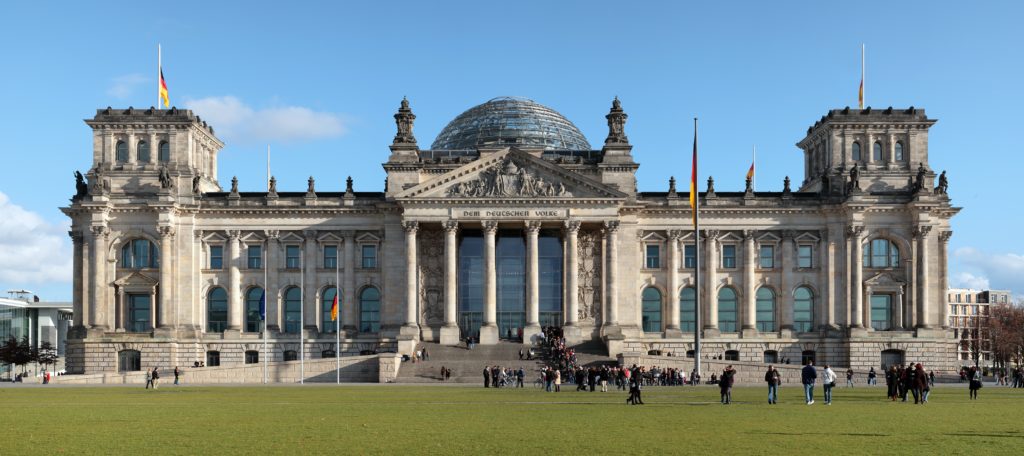
Heute vor vierundachtzig Jahren war der Reichstagsbrand.
Eighty-four years ago today, the German Reichstag burned.
Under the post-World War I constitution (“The Weimar Republic”), the German President had incredible power.
The President could call for new Parliamentary elections, could replace the Chancellor (which is what Germans call the head of Parliament, aka The Prime Minister), could declare states of emergency, and effectively write laws under those states of emergency without Parliament’s consent.
In 1932, the NSDAP (the Nazis) campaigned on the fears that Germany was under imminent threat from being infiltrated by Communists. If they were elected, they promised, they would urge the President to call for new elections, confront the Communist threat, and outlaw the KPD.
In early 1933, the NSDAP had the most seats in Parliament, so their candidate (a man named Adolf Hitler) became Chancellor, even though they only had 33% of the seats. They succeeded in convincing the President (a man named Paul von Hindenburg), to call new elections because of the dangerous Communist threat, and the new elections were scheduled for March 5, 1933.
On the night between February 27 and February 28, 1933, the building that housed Parliament, the Reichstag, caught fire and burned. A Dutch man named Marinus van der Lubbe, who was conveniently 1) a foreigner and 2) a Communist, was apprehended at the scene and charged with arson.
There is considerable historical debate about whether or not van der Lubbe actually set the fire. It’s completely possible that he did, because he wanted to trigger a Communist revolution in Germany. It’s also completely possible that the Nazis set the fire themselves and found a patsy.

The phrase Dem Deutschen Volke, “To the German people”, still extant today, is visible
Whoever set the fire, the Nazis took advantage. The next day, President Hindenburg named the event a constitutional emergency, and signed a law which essentially suspended all constitutional rights.
In the special elections on March 5, the Nazis were hoping for an absolute majority between 50% and 55%. They didn’t get it, and only came in at 44%. Another right-wing party, though, the DNVP, was sympathetic to the NSDAP and won 8% of the vote.
They controlled a combined 52% majority in Parliament. Because of the emergency situation declared by the President, they were able to arrest anyone who dissented, they were able to censor and control the press, they were able to stop public protests, and they were able to listen in to phone conversations and intercept mail to stay one step ahead of the opposition. The Nazis used their paramilitary organization, the SA (aka “Brownshirts”) to physically threaten and restrain what little opposition remained.
The NSDAP and its smaller sympathizers kept pushing. They eventually passed an Ermächtigungsgesetz (an “Enabling Act” which constitutionally required a ⅔ vote of Parliament), allowing the Chancellor to write and execute laws without Parliament’s or the President’s consent. On March 27, 1933 — one month after the Reichstag burned — the Chancellor became the de facto dictator of Germany.
So here we are, 84 years later.
One of the biggest criticisms of the Weimar Republic in which Hitler and the NSDAP seized control was that it didn’t clearly separate powers. The President could redo the legislature. The legislature can do away with the President’s powers. Either one of them could simply go over the constitutional protections of the courts by shouting “Emergency!”
On the other hand, separation of powers can only protect a people so far. Let’s assume that van der Lubbe really did start the fire. I’m sure the NSDAP did things that were more thsan questionable (that goes without saying). Most things that the Nazis did, though, to gain power were legal and constitutional.
Their tactics were simple. Keep pushing the idea that we’re under attack. Keep lying that the only way to stay safe was to trust the entire apparatus of state to one small group (the real Germans). Keep insisting that the “emergency” is temporary so we can just figure out what’s going on. Keep public protests to a minimum. Keep a free press from publishing dissenting facts.
There is, 84 years later, a ray of hope in all this.
The German Word Reichstag is literally “empire-meeting”. (This is sometimes translated “Diet of the Realm”, but that seems sort of silly.) If you know the German phrase Guten Tag, you know that the word Tag literally means “day”. Germans use the word -tag to mean the work a collection of people literally do in a day — an assembly.
Today, Germany has dropped the idea of Reich from its government. Today, the legislature calls itself the Bundestag, the Federal Parliament. The NSDAP government never used the Reichstag building again, but the current German government does.
After German reunification in 1990, the Reichstag building was completely renovated. When you enter, all the walls between the entrance facade and the speaker’s podium are glass. Instead of the original ornate, pointed dome, architect Norman Foster designed a glass dome overhead. The dome has an array of mirrors which let natural sunlight in to the debate chamber.

The first time I visited the building in 2000, I was amazed how the architectural analogy of the building is everywhere: transparency. One can see from the dome down to the speaker’s podium. You can walk around ramps in the capitol to see complete panoramas of Berlin. Even the railings and partitions in the visitor’s galley of the main chamber are glass.
The transition from Reich (“kingdom” or “empire”) to Bundesrepublik (“federal republic”) meant for Germans that the German public and the world can see past the ashes of nationalism into the heart of their democracy.

